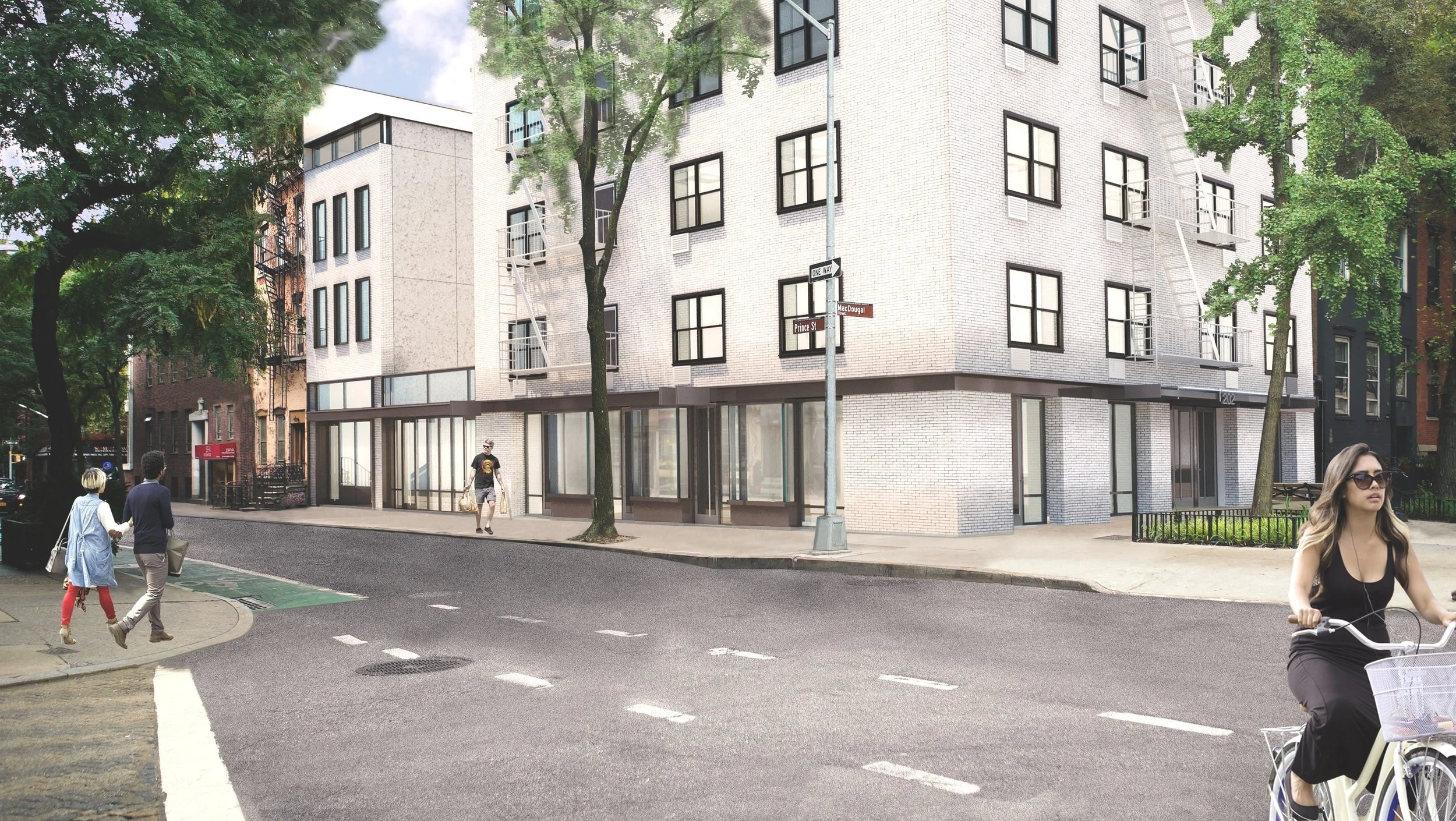200 Prince Street & 202 Avenue of the Americas, Sullivan-Thompson Historic District, NYC: the Prince Street Restaurant building
transforming non-contributing buildings in an historic district into a contributing complex
Location: 200 Prince Street, 202-204 Avenue of the Americas
Project Size: 8,000 SF
Project Type: Reconstruction, Adaptive reuse (from Residential to Commercial)
TRA studio’s Assistance : Historical Research, Architectural Design + Documentation, Interior Design, FFE, Lighting, Architectural Graphics, Development Strategy, LPC filing
Prince Street Buildings
Thompson Sullivan Historic District
THE SITE
The project entails the renovation of two buildings and the erection of a new one story commercial building, all located on a single zoning lot, at the corner of Avenue of the Americas and Prince Street.
The three "lots" should be considered as part of a complex, which we refer to as the Prince Street Buildings . The redesign of the structures was commissioned in 1960 to the Architect David Kraus, the renovation affected the row houses located at 202-204 Av. of the Americas, which were enlarged and combined into one structure, 200 Prince, as well as the demolition of a pre-existent two stories commercial building to allow for light and air to the larger Avenue of the Americas building. The 1960 upgrade and modernization, included the re-cladding of the resulting structures with white brick, fashionable at the time, an approximately a 12’ feet high white brick wall connecting the structures, .clearly signaling the intention to unify the portion of the block in question into a single complex.
The evolution of the typology of the preexisting row houses into the typology of the so-called white brick apartment complex is part of the history of the district and should, in our opinion, be seen as having historical significance.
The two buildings standing today, have been classified in the Thompson-Sullivan Historic District Report as non-contributing and elsewhere described, as “no style”. The two structures are separated by an open lot which breaks the continuity of the street wall. The two non-contributing buildings do however retain the scale of the original buildings and can be considered, in that sense, part of the existing fabric.
The Prince Street building this is a diminutive 19’x34’ tenement building housing 8 minuscule residential studios in poor condition. The façade has been completely stripped and replaced with white brick cladding, the window openings have been reduced in size, thru-the-wall air conditioning units and utilitarian fire-escapes complete the treatment. The basement level is located exactly 36” below ground, making the required handicapped accessibility simply impossible to achieve without major alterations, such as the removal of the first floor slab.
The open lot: an utilitarian retractable gate connects the open lot to the Sixth Avenue building, as seen in the tax photo shown previously, originally a white brick wall, now gone, unified the entire complex. The area is used as the service area of the deli and houses mechanical equipment that should not be there. It does provide egress for the fire escape located on the East wall of the Avenue of Americas Building, which is blocked by the roll-down gate.
202 AVENUE OF THE AMERICAS
The makeover aspires to the aesthetic of the white brick residential buildings that were popular in the 60s, several similar examples are present in the District, the white brick rental building is the natural evolution of the typologies found in the District: from row houses, to tenement buildings and finally rental buildings. Behind the white brick façade remnants of the two original tenement buildings still partially exist.
The ground floor is presently punctured by a random collection of openings which neither qualify as a storefront nor recall the door/window combination repetition, typical of doctors offices, that is seen in the 1980’s tax photo, the first floor in its current condition is neither commercial or residential in feeling.
THE RENOVATION OF THE COMPLEX
The client, asked us to repair the fabric of the block, by filling the open court with a single floor commercial structure connecting, as in the 1960’s renovation, the building on Prince Street for commercial use and redesign the entire storefront of the Avenue of the Americas building .
As it is true of several buildings in the District, since the lot s overbuilt, the renovation requires us to maintain the overall existing bulk, specifically we had to redistribute the square footage of the Prince Street Building, ( about 3000 square feet), so to fill the empty lot, while maintaining at least 25% of the existing structure.
Having to work “with” the Prince Street building rather than demolishing and building new, the project morphed into reinventing what we found, essentially an “object trouve’”. Preservation in this case does not entail the heroic restoration of the details, but rather the pragmatic preservation of the scale of the street.
The proposed storefronts, that morph all along Prince Street according the different characteristics of each structure, restitute to the block the lively , varied , street life that is one of the main characteristic of the District.
THE PROPOSED DESIGN ELEMENTS
The storefronts: since, one of the most significant and contributing characteristic of the District is the treatment of the buildings of the street level, which is animated by the varied the architectural elements, often characterized by projecting bay windows storefronts, the renovation addresses in particular the first floor.
The recurring separation of use, materials and detailing between the ground floor and the upper floors, often seen in the area, is re-proposed by the signage fascia that ties the complex together.
The first floor storefront, proposes simple but crisp metal frames that can co-exhist in proximity of the existing metal window frames. The storefront, whose scale and geometry morphs both along Prince Street and Avenue of the Americas, changes character to fit harmoniously responding to the different conditions. The morphing of the first floor treatment to respond to different conditions has been observed in the architecturally significant 1920s building located at 210 Avenue of the Americas nearby.
The Prince Street building: the thoughtful design solution retains the original brick walls on two sides of the Prince Street Building. The façade, which is nothing more than a badly installed cheap mask replacement, is reconstructed in kind, but also lifted and sculpted to allow for the commercial ground floor . The rhythm, scale and texture of the upper windows is maintained where it is most visible to fit within the existing fabric, while the introduction of the glass railing at the top rebalances the top floor, which was stripped of the tall cornice and most likely altered to increase the height of the top residential unit.
The open lot the storefront continues with folding metal doors that, when open, dissolve to recall the flower shop that has occupied the site for many years. The view thru the building reveals the green wall of the open court in the back, court that has been intentionally left open to preserve the
presence of the rear yards in the District.
The Sixth Avenue building, whose upper portion above the signage band, is not part of the renovation, the design of the storefront takes both its cues from the projecting storefronts that populate the District and that appeared on the building that stood in its place on Prince Street and from the regularly spaced window/door units that characterized the ground floor offices in the 60’s renovation. The storefront becomes increasingly more solid on the Sixth Avenue side, where the building retains more of the first floor residential characteristics. The residential entrance is signaled by a modest projecting canopy.
THE CATALYTIC EFFECT: THE DOWNTOWN PROJECTS
The studio’s numerous projects in Downtown Manhattan have all played a spin off role in enhancing their respective neighborhoods and all have given back with overarching citywide importance, each intervention adding to a catalytic reaction at urban scale.
The numerous interventions along Mercer Street, West Broadway and Prince Street and more recently in the Tribeca area South of Canal, contributed to the “making of the street”, acting as anchors in the commercial SoHo District and the lower Broadway corridor.











